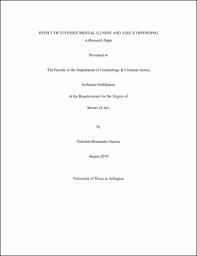
ATTENTION: The works hosted here are being migrated to a new repository that will consolidate resources, improve discoverability, and better show UTA's research impact on the global community. We will update authors as the migration progresses. Please see MavMatrix for more information.
Show simple item record
| dc.contributor.advisor | Davis, Jaya B. | |
| dc.contributor.advisor | El Sayed, Sarah | |
| dc.creator | Hernandez-Garcia, Gabriela | |
| dc.date.accessioned | 2019-09-03T15:51:15Z | |
| dc.date.available | 2019-09-03T15:51:15Z | |
| dc.date.created | 2019-08 | |
| dc.date.issued | 2019-08-06 | |
| dc.date.submitted | August 2019 | |
| dc.identifier.uri | http://hdl.handle.net/10106/28667 | |
| dc.description.abstract | Individuals with mental illness interact with both the juvenile and adult criminal justice
systems. Over 50% of inmates in jail and prisons have been diagnosed with mental health
problems (James & Glaze, 2006; Al-Rousan, et al. 2017; Wilson & Wood, 2014; Torrey, 1995),
while offenders in the juvenile justice system appear to have considerably higher rates of mental
illness than those who do not offend (Cashman & Thomas, 2017). The current study utilizes data
obtained from The National Longitudinal Study of Adolescents Health (Add Health).
Adolescents from “selected schools, urbanity, school size and school type,” (Beaver, 2013,
Daigle & Teasdale, 2018) were randomly selected during 1994-1995 to take a survey. | |
| dc.format.mimetype | application/pdf | |
| dc.language.iso | en_US | |
| dc.subject | Mental health | |
| dc.subject | Mental illness | |
| dc.title | EFFECT OF JUVENILE MENTAL ILLNESS AND ADULT OFFENDING | |
| dc.type | Thesis | |
| dc.degree.department | Criminology and Criminal Justice | |
| dc.degree.name | Master of Arts in Criminology and Criminal Justice | |
| dc.date.updated | 2019-09-03T15:51:15Z | |
| thesis.degree.department | Criminology and Criminal Justice | |
| thesis.degree.grantor | The University of Texas at Arlington | |
| thesis.degree.level | Masters | |
| thesis.degree.name | Master of Arts in Criminology and Criminal Justice | |
| dc.type.material | text | |
| dc.creator.orcid | 0000-0002-6380-1740 | |
Files in this item
- Name:
- HERNANDEZ-GARCIA-THESIS-2019.pdf
- Size:
- 169.5Kb
- Format:
- PDF
This item appears in the following Collection(s)
Show simple item record


